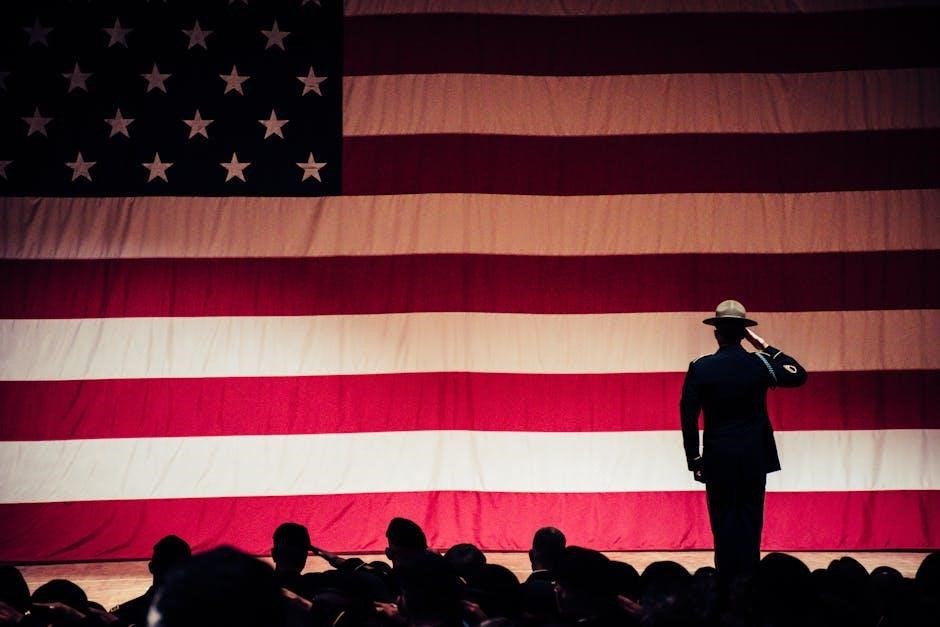give me liberty volume 2 pdf
Summary
Download Give Me Liberty Volume 2 PDF for free. Instant access to the full book. Start reading now!

Eric Foner’s Give Me Liberty! Volume 2 explores American history from Reconstruction to the 21st century, emphasizing freedom’s evolution and societal transformations. Authoritative and concise, it provides a rich understanding of the nation’s development, focusing on key themes like equality, democracy, and global influence. This volume is a seminal work for students and historians alike, offering a comprehensive narrative of America’s complex past and its enduring quest for liberty.
Overview of the Book
Give Me Liberty! Volume 2 by Eric Foner is a comprehensive exploration of American history from Reconstruction to the 21st century. This volume delves into the nation’s transformation, focusing on themes such as freedom, equality, and democracy. Foner examines the societal, political, and economic shifts that shaped the United States, providing a nuanced understanding of key events and movements. The book is structured to offer a clear narrative, making it accessible to students and scholars alike. Its concise yet detailed approach ensures a deep exploration of America’s complex past, highlighting the ongoing struggle for liberty and its multifaceted meanings. This volume is a vital resource for understanding the nation’s development and its enduring pursuit of freedom.
Author Background: Eric Foner
Eric Foner is a Pulitzer Prize-winning historian renowned for his work on American history, particularly the Civil War and Reconstruction. Born in 1943, Foner is a professor at Columbia University, where he has taught since 1982. His writing often explores themes of freedom, race, and democracy. Foner’s scholarship has earned him numerous accolades, including the Presidential Medal of Freedom in 2012. His ability to synthesize complex historical narratives into accessible prose has made his works, like Give Me Liberty!, essential for both academics and general readers. Foner’s contributions have significantly shaped the understanding of American history and its enduring relevance.
Significance of the Second Volume
Give Me Liberty! Volume 2 is pivotal as it chronicles the transformation of the United States from the late 19th century to the present. This volume captures the nation’s struggle with industrialization, global conflicts, civil rights movements, and social change. Foner’s narrative bridges historical events with contemporary issues, offering insights into the evolving concept of freedom. The text is invaluable for understanding modern America, as it connects past challenges to current societal and political dynamics. Its comprehensive approach makes it a cornerstone for historical education, providing a nuanced perspective on the American experience and its ongoing pursuit of liberty and equality.

Historical Context of the Late 19th and Early 20th Centuries
The late 19th and early 20th centuries saw industrialization, urbanization, and social reform shape America’s identity, setting the stage for global involvement and internal transformation.
The Gilded Age and Its Impact on American Society
The Gilded Age, spanning the late 19th century, was marked by rapid industrialization, urbanization, and significant social change. This period saw the rise of “robber barons” like Rockefeller and Carnegie, who amassed vast fortunes, while millions of Americans faced poverty and inequality. The era was characterized by technological advancements, mass immigration, and the growth of consumer culture. However, it also witnessed labor unrest, racial tensions, and political corruption. Give Me Liberty! Volume 2 examines how these developments shaped American society, highlighting the contrast between economic prosperity and social inequality. The Gilded Age laid the groundwork for the Progressive Era’s reforms and continues to influence contemporary debates on capitalism and democracy.
The Progressive Era: Reform and Change
The Progressive Era, spanning the late 19th to early 20th centuries, was a period of significant social, political, and economic reform in the United States. Driven by concerns over industrialization’s negative impacts, Progressives sought to address issues like income inequality, corporate power, and political corruption. Reforms included trust-busting policies, labor laws, and women’s suffrage. Key figures like Theodore Roosevelt and Jane Addams championed these changes. The era also saw the rise of muckraking journalism, which exposed societal ills and galvanized public support for reform. While the movement achieved notable successes, it also faced limitations, particularly in addressing racial disparities. Give Me Liberty! Volume 2 explores how these reforms reshaped American democracy and society, leaving a lasting legacy for future generations.

World War I and Its Aftermath
World War I marked a pivotal moment in American history, as the nation transitioned from neutrality to active participation in global conflict. The U.S. entered the war in 1917, driven by Germany’s resumption of unrestricted submarine warfare and the Zimmermann Telegram. The war effort spurred economic mobilization and enhanced federal authority but also strained civil liberties, as seen in the Espionage and Sedition Acts; The Treaty of Versailles, though ending the war, failed to establish lasting peace, contributing to widespread disillusionment. Post-war America experienced social unrest, including the Red Scare and the Palmer Raids, which targeted radicals and immigrants. Meanwhile, the Harlem Renaissance emerged, celebrating African American culture. Give Me Liberty! Volume 2 examines how World War I reshaped America’s role on the global stage and its internal struggles with freedom and identity. The war’s aftermath set the stage for the turbulent 1920s and beyond.

The Roaring Twenties and the Great Depression
The Roaring Twenties brought cultural and economic prosperity, while the Great Depression plunged America into financial crisis, reshaping societal norms and governmental interventions, as explored in Foner’s narrative.
Cultural Shifts of the 1920s
The 1920s marked a transformative era in American culture, characterized by the Harlem Renaissance, which celebrated African American art and identity, and the rise of jazz music. This period saw the emergence of the “flapper,” symbolizing women’s liberation and a break from traditional gender roles. Consumer culture flourished, with new technologies and mass production making cars, radios, and household goods more accessible. Hollywood’s influence expanded, shaping entertainment and national identity, while sports became a unifying force in American life. However, this cultural boom coexisted with growing nativism and Prohibition, leading to tensions and the rise of organized crime. These shifts laid the groundwork for modern American culture, blending progress with underlying social complexities.
Economic Boom and Bust
The 1920s witnessed an extraordinary economic boom, driven by industrial expansion, mass production, and consumer spending. The automotive and construction industries flourished, while stock markets reached record highs, fostering a culture of speculation. However, underlying weaknesses in the economy, such as unequal income distribution and overproduction, set the stage for the Great Depression. The 1929 stock market crash marked the end of prosperity, plunging the nation into economic despair. Unemployment soared, and widespread poverty became rampant. President Franklin D. Roosevelt’s New Deal sought to revive the economy through reforms and public works projects, reshaping America’s financial landscape and laying the foundation for future recovery.
The New Deal and Its Legacy
The New Deal, introduced by President Franklin D. Roosevelt, was a transformative series of programs and policies aimed at addressing the economic and social crises of the Great Depression. It focused on providing relief to the unemployed, reforming the financial system, and stimulating recovery through infrastructure projects. Key initiatives included the Works Progress Administration, the Civilian Conservation Corps, and the Social Security Act, which established a social safety net. The New Deal not only revitalized the economy but also redefined the role of government in addressing societal challenges. Its legacy endures in modern social welfare programs and the continued debate over government intervention in economic affairs.

World War II and the Cold War Era
World War II and the Cold War Era explores America’s pivotal role in global conflicts, ideological battles, and societal shifts, shaping the nation’s identity and international influence.
America’s Role in World War II
America’s involvement in World War II marked a turning point in global history. Initially maintaining neutrality, the U.S. entered the war after the Japanese attack on Pearl Harbor in 1941. The nation mobilized its vast industrial and military resources, playing a pivotal role in Allied victories in both Europe and the Pacific. Key events included the D-Day invasion of Normandy and the atomic bombings of Hiroshima and Nagasaki. On the home front, the war spurred economic growth and social changes, such as increased female participation in the workforce. The U.S. emerged as a superpower, shaping the postwar world order and setting the stage for the Cold War. Its leadership and sacrifices cemented its global influence.
The Origins of the Cold War
The Cold War emerged from post-World War II tensions between the United States and the Soviet Union. Ideological differences over capitalism and communism fueled rivalry. The Yalta and Potsdam conferences revealed growing mistrust, particularly over Soviet influence in Eastern Europe. The Truman Doctrine and Marshall Plan, aimed at containing communism, heightened tensions. The division of Europe into Western and Soviet spheres solidified the conflict. The Cold War became a defining feature of international relations, shaping global politics, economies, and cultures for decades. Its origins laid the groundwork for decades of espionage, proxy wars, and nuclear brinkmanship, profoundly impacting American society and foreign policy.
McCarthyism and Its Effects on Society
McCarthyism, emerging in the 1950s, was a period of intense anti-communist hysteria led by Senator Joseph McCarthy. It fueled fears of Soviet infiltration, leading to blacklists, political witch-hunts, and the suppression of dissent. The Red Scare targeted intellectuals, artists, and government employees, damaging careers and fostering a climate of fear. The House Un-American Activities Committee (HUAC) played a central role in scrutinizing alleged communists. McCarthyism eroded civil liberties, stifled free expression, and divided American society. Its excesses ultimately led to a backlash, but the era left a lasting impact on American politics and culture, highlighting the dangers of unchecked paranoia and authoritarianism.

The Civil Rights Movement
The Civil Rights Movement sought to end racial segregation and discrimination, achieving landmark legislation like the Civil Rights Act of 1964 and inspiring social justice efforts.
Key Events and Figures
The Civil Rights Movement was marked by pivotal events and influential figures who fought for racial equality and justice. The March on Washington in 1963, where Dr. Martin Luther King Jr. delivered his iconic “I Have a Dream” speech, was a defining moment. Rosa Parks’ courageous act of defiance in 1955 sparked the Montgomery Bus Boycott, while the 1964 Civil Rights Act and 1965 Voting Rights Act were landmark legislative achievements. Figures like Malcolm X and Thurgood Marshall also played significant roles, advocating for equality through different approaches. These events and leaders collectively shaped the movement, leaving a lasting impact on American history and the fight for freedom.
Legislative Changes and Social Impact
The Civil Rights Movement led to transformative legislative changes, profoundly impacting American society. The Civil Rights Act of 1964 outlawed discrimination based on race, color, religion, sex, or national origin, while the Voting Rights Act of 1965 protected African Americans’ voting rights. These laws dismantled systemic barriers, enabling greater political participation and social equality. The Fair Housing Act of 1968 further advanced equality by prohibiting housing discrimination. These legislative milestones not only reshaped legal frameworks but also fostered societal progress, encouraging diverse representation and challenging entrenched prejudices. Their enactment marked a significant step toward realizing the promise of liberty and equality for all Americans.
The Movement’s Legacy
The Civil Rights Movement left an indelible mark on American history, inspiring future struggles for justice and equality. It demonstrated the power of nonviolent resistance and grassroots activism, shaping movements for women’s rights, LGBTQ+ rights, and environmental justice. The movement redefined American identity, challenging the nation to live up to its founding ideals of liberty and equality. Its legacy continues to influence contemporary debates on racial justice, voting rights, and systemic inequality. By fostering a more inclusive society, the movement remains a cornerstone of American progress, reminding future generations of the importance of collective action and the enduring pursuit of freedom.

Modern American History (1970s to 2000s)
This period saw significant societal, political, and technological shifts, including the end of the Cold War, the rise of the internet, and movements for civil rights.
Political Shifts and Social Movements
The late 20th century witnessed significant political and social transformations. The 1970s and 1980s saw the rise of conservatism, exemplified by Ronald Reagan’s presidency, which emphasized limited government and free-market economics. Conversely, liberal movements advocating for civil rights, women’s rights, and environmental protection gained momentum. The 1990s brought debates over globalization and cultural identity, while the 2000s were marked by the War on Terror and its societal impacts. Social movements, such as feminism, LGBTQ+ rights, and racial justice, continued to reshape American society. These shifts reflected evolving notions of freedom, equality, and democracy, as the nation grappled with its changing demographics and global role.
Economic Challenges and Globalization
The late 20th and early 21st centuries saw the U.S. face significant economic challenges, including globalization’s impact on domestic industries. The rise of multinational corporations and international trade reshaped the workforce, often benefiting corporations while displacing workers. The 2008 financial crisis exposed vulnerabilities in the economy, leading to widespread unemployment and a renewed debate over regulation. Globalization also created opportunities, as American businesses expanded abroad, but it intensified economic inequality at home. Policymakers struggled to balance free-market principles with social welfare, while the nation adapted to a more interconnected world. These economic shifts underscored the complexities of maintaining prosperity in an increasingly globalized era.
Technological Advancements and Their Impact
The late 20th and early 21st centuries witnessed transformative technological advancements that reshaped American society. The rise of the internet, mobile devices, and digital media revolutionized communication and commerce. These innovations fostered global connectivity and economic growth but also introduced challenges such as privacy concerns, job displacement, and the spread of misinformation. The digital divide highlighted inequities in access to technology, while automation impacted various industries. Overall, technological progress has been a double-edged sword, driving innovation and efficiency while necessitating adaptive responses to emerging societal issues.

Contemporary Issues and Reflections
Modern America faces ongoing debates over freedom, equality, and justice, shaped by globalization, technological change, and social movements, reflecting enduring themes from its historical journey.
Current Social and Political Challenges
Modern America grapples with pressing issues like racial inequality, political polarization, and economic disparity, echoing themes from its past. The legacy of slavery and segregation continues to manifest in systemic racism, while debates over voting rights and immigration highlight ongoing struggles for equality. Climate change and technological advancements further complicate the landscape, raising questions about freedom and responsibility. Foner’s analysis in Give Me Liberty! Volume 2 provides a historical lens to understand these challenges, emphasizing how the pursuit of liberty remains central to addressing contemporary societal fractures. These issues underscore the enduring relevance of America’s historical journey in shaping its future.
Lessons from History

History provides invaluable lessons, offering insights into the complexities of human progress and the enduring struggle for freedom. By examining past events, such as the Civil Rights Movement and the Great Depression, we gain a deeper understanding of how societal structures and policies shape individual liberties. Eric Foner’s Give Me Liberty! Volume 2 highlights how historical patterns, like the pursuit of equality and the impact of economic systems, continue to influence contemporary issues. These lessons remind us that freedom is not static but evolves through collective action and political engagement. Understanding history empowers us to address current challenges and strive for a more equitable future, ensuring that the principles of liberty remain central to American society.
The Future of American Freedom
The future of American freedom hinges on addressing contemporary challenges while upholding the principles of equality and justice. As explored in Give Me Liberty! Volume 2, freedom is an ever-evolving concept, shaped by societal progress and setbacks. The pursuit of liberty requires active engagement with issues like political polarization, economic inequality, and racial justice. By learning from history, Americans can foster a more inclusive democracy, ensuring that freedom remains a fundamental human right for all. The path forward demands collective efforts to safeguard civil liberties, promote education, and strengthen democratic institutions, guaranteeing that the promise of freedom endures for generations to come.
Give Me Liberty! Volume 2 masterfully concludes with reflections on freedom’s enduring significance, highlighting the interplay of equality, democracy, and global influence in shaping America’s modern identity.
Summarizing Key Themes
Give Me Liberty! Volume 2 delves into the transformative periods of American history, focusing on themes like freedom, equality, and democracy; It explores the nation’s evolution from Reconstruction to the 21st century, highlighting struggles for civil rights, economic shifts, and global influence. Foner examines how freedom has been redefined over time, shaped by societal changes and political movements. The book underscores the tension between liberty and inequality, offering insights into America’s ongoing quest for a more just society. By weaving together political, social, and cultural narratives, Foner provides a comprehensive understanding of the nation’s complex journey toward true democracy and the enduring pursuit of freedom.
The Enduring Relevance of “Give Me Liberty!”
Give Me Liberty! Volume 2 remains a cornerstone of American historical study, offering timeless insights into the nation’s evolution. Its exploration of freedom, equality, and democracy resonates deeply with contemporary discussions on civil rights and social justice. By examining pivotal events and enduring struggles, Foner’s work bridges the past and present, illuminating the ongoing pursuit of liberty. The PDF version enhances accessibility, making this vital resource available to a broader audience. Its relevance lies in its ability to contextualize historical patterns that shape today’s challenges, ensuring it remains an essential tool for understanding America’s identity and its continued quest for a more equitable society.
Final Thoughts on Volume 2
Give Me Liberty! Volume 2 concludes with a profound reflection on the intertwined themes of freedom, equality, and democracy in American history. Eric Foner masterfully weaves together the complexities of the nation’s development, from the Civil War’s aftermath to contemporary challenges. The text underscores the enduring struggle for liberty, highlighting how historical events continue to shape modern societal dynamics. The PDF version of this volume ensures accessibility for scholars and students, offering a seamless way to engage with Foner’s meticulous research. By connecting past and present, Give Me Liberty! Volume 2 not only educates but also inspires readers to critically evaluate the ongoing pursuit of freedom in America.

Additional Resources for “Give Me Liberty! Volume 2 PDF”
Access the PDF version of Give Me Liberty! Volume 2 through online libraries, eBook platforms, or the publisher’s website. Supplementary materials like study guides and lecture notes are also available to enhance understanding.
Where to Find the PDF Version
The PDF version of Give Me Liberty! Volume 2 can be easily accessed through various online platforms. University libraries often provide digital copies for students and researchers. Additionally, online retailers like Amazon and Barnes & Noble offer eBook versions for purchase. For those seeking free access, platforms like Google Books or academic databases may have preview chapters or excerpts. Some websites specialize in hosting PDFs of educational texts, though users should ensure they are accessing from legitimate sources. Students can also check their institution’s online portals, as many universities provide e-textbooks through their libraries. Using specific search terms like “Give Me Liberty Volume 2 PDF” can help locate reliable sources quickly and efficiently.
Benefits of the Digital Format
The digital format of Give Me Liberty! Volume 2 offers unparalleled convenience and accessibility. Students can easily carry the PDF on laptops, tablets, or smartphones, eliminating the need for physical copies. The digital version allows for instant access to historical content, enabling quick searches, bookmarking, and note-taking. This format is particularly beneficial for researchers, as it facilitates easy reference and citation. Additionally, the PDF version reduces environmental impact by minimizing paper usage. Its portability and searchability make it an ideal choice for modern learners, ensuring that the rich historical insights of Foner’s work are readily available at all times. This modern approach to learning enhances both efficiency and engagement for students and scholars alike.
Supplementary Materials for Study
The Give Me Liberty! Volume 2 PDF is often accompanied by supplementary materials designed to enhance learning. These include online study guides, interactive timelines, and primary source documents that provide deeper context to historical events. Additionally, many digital versions offer access to quizzes, flashcards, and chapter summaries to aid in retention. Some platforms also feature video lectures or podcasts that complement the text, offering alternative perspectives and explanations. These resources are particularly useful for students seeking to engage with the material on multiple levels, ensuring a comprehensive understanding of American history. Such tools make the study experience more interactive and enriching.